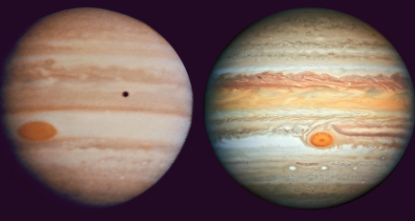Why is Jupiter’s Great Red Spot Shrinking?
The biggest storm in our solar system, the Great Red Spot (GRS) on Jupiter, is getting smaller right now. Some scientists think that this change might be linked to fewer small storms that normally help keep the GRS running. The GRS is a huge high-pressure storm in Jupiter’s southern hemisphere that was first seen in the middle 1600s. In the late 1800s, systematic studies began to show how it was changing all the time, which led to new ideas about its structure and dynamics.
Structure and Dynamics of the GRS
The GRS covers about 16,000 km and has winds that are faster than 321 km/h. It goes down almost 250 km through Jupiter’s atmosphere, through layers of clouds that are full of ammonia. Scientists have been trying to figure out why there has been a noticeable shrinkage over the last 100 years.
Research and Hypothesis
Caleb Keaveney, a graduate student at Yale, suggested that the GRS might be being affected by the decrease in smaller storms. His group used the Explicit Planetary Isentropic-Coordinate (EPIC) model to simulate how the GRS and different smaller storms would interact with each other. They then compared the results of these simulations to those that did not include these smaller storms. The studies showed that smaller storms are very important for keeping the GRS going and making it bigger. These smaller systems seem to keep the storm’s size the same, but if they’re not there, the storm may get smaller over 2.6 Earth years.
Comparison with Earth’s Weather Systems
Similar long-lasting high-pressure systems can be found on Earth. They are called “heat domes,” and they often change the way violent weather happens. The study suggests that interactions with weather events in the area help both Earth’s heat domes and Jupiter’s GRS last longer. The GRS’s size has changed, and its color has also changed, mostly from reddish-orange to pinkish-orange. This shows that sun radiation has caused complex chemical reactions. These color changes are caused by changes in chemicals in the storm.
About Great Red Spot
- Massive, Long-Lasting Storm: The Great Red Spot on Jupiter is a colossal storm, twice the size of Earth, that has persisted for over 350 years. This high-pressure system produces counterclockwise winds reaching speeds of up to 432 km/h (268 mph).
- Reddish Hue and Chemical Reactions: The unique red color of the storm is probably caused by complicated chemical processes in Jupiter’s atmosphere involving ammonia and other compounds. It is these responses that give the Great Red Spot its unique color, which is being studied right now.
- Observation and Changes: Since the late 19th century, the Great Red Spot has been shrinking, but the reasons for this are still unclear. The Voyager 1 and 2 spacecraft gave the first close-up images in 1979, giving detailed insights into its unique dynamics and structure.
Month: Current Affairs - July, 2024
Category: Science & Technology Current Affairs







